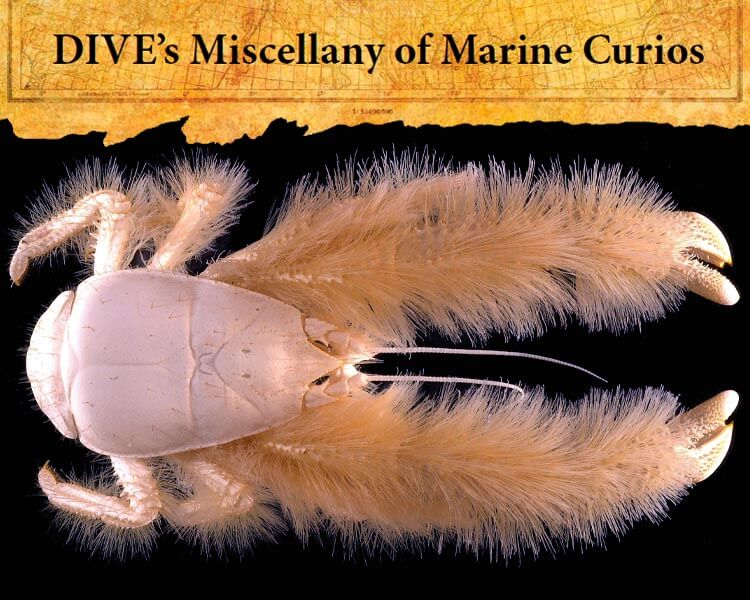
Kiwa hirsuta or Yeti crab – prefers it not too hot, and not too cold, but just right, down there in its hairy hydrothermal depths.
The Yeti crab (Kiwa hirsuta), blind, remarkably hairy, and about 15cm in length, was first observed by scientists from the Monterey Bay Aquarium Research Institute in 2005 on a hydrothermal vent near Easter Island in the Pacific.
This unusual decapod – distantly related to the more familiar reef-dwelling squat hairy lobster – was discovered at a depth of around 2,200m by scientists on board MBARI’s deep-sea submersible, Alvin. It was thought at first to be a new species, but actually turned out to be an entirely new family of crustaceans.
The yeti crabs (also sometimes called yeti lobsters) live in dense colonies, often with more than 700 individuals jammed into a square metre. They inhabit the tiny sliver of territory beside the hydrothermal vents where it is neither too hot (the vents spew out noxious fluids at temperatures in excess of 700ºC) nor too cold (at 2,200 metres the ambient temperature on the sea floor is around 2ºC).
Unlike other similar species, the female yeti crab will carry her eggs to brood – but in doing so must leave the balmy 32ºC waters which they usually inhabit, as the water close to the hydrothermal vents is too toxic for the eggs to survive. Once her eggs have hatched, the mother crab usually dies from the cold.
The Yeti crab was named after Kiwa, the Polynesian goddess of shellfish, with the second half of the name, hirsuta, is the Latin word for ‘hairy.’ The newly-named genus, Kiwa, was recognised as belonging to a newly-described family, Kiwaidae, in 2006.
The Yeti crabs appear to farm the food on which they survive. They dangle symbiotic bacteria living in the hairs of the arms into the toxic miasma pouring from the hydrothermal vents, which convert the chemicals into energy through a process known as chemosynthesis. They then consume the crop.
In order to make sure the bacteria are provided with a constant supply of chemicals to process, they wave their claws through the outflow, which has earned them the nickname ‘dancing crab.’
Since 2005, five other species in the genus have been discovered near other deep-sea vents, including Kiwa puravida, Kiwa araonae and Kiwa tyleri – affectionately named the ‘Hoff crab’, after TV star David Hasselhoff’s famously hairy arms. the fifth species remains as yet undescribed.
More from DIVE’s Miscellany of Marine Curios:
- Marine Curios #13 – Marrus orthocanna, a pelagic siphonophore
- Marine Curios #12 – Clione limacina, or naked sea butterfly
- Marine Curios #11 – order Xiphosura, or horseshoe crabs
- Marine Curios #10 – Pseudocolochirus violaceus or sea apple
- Marine Curios #9 – Periophthalmus modestus or Shuttles hoppfish
- The complete collection of DIVE’s Miscellany of Marine Curios


